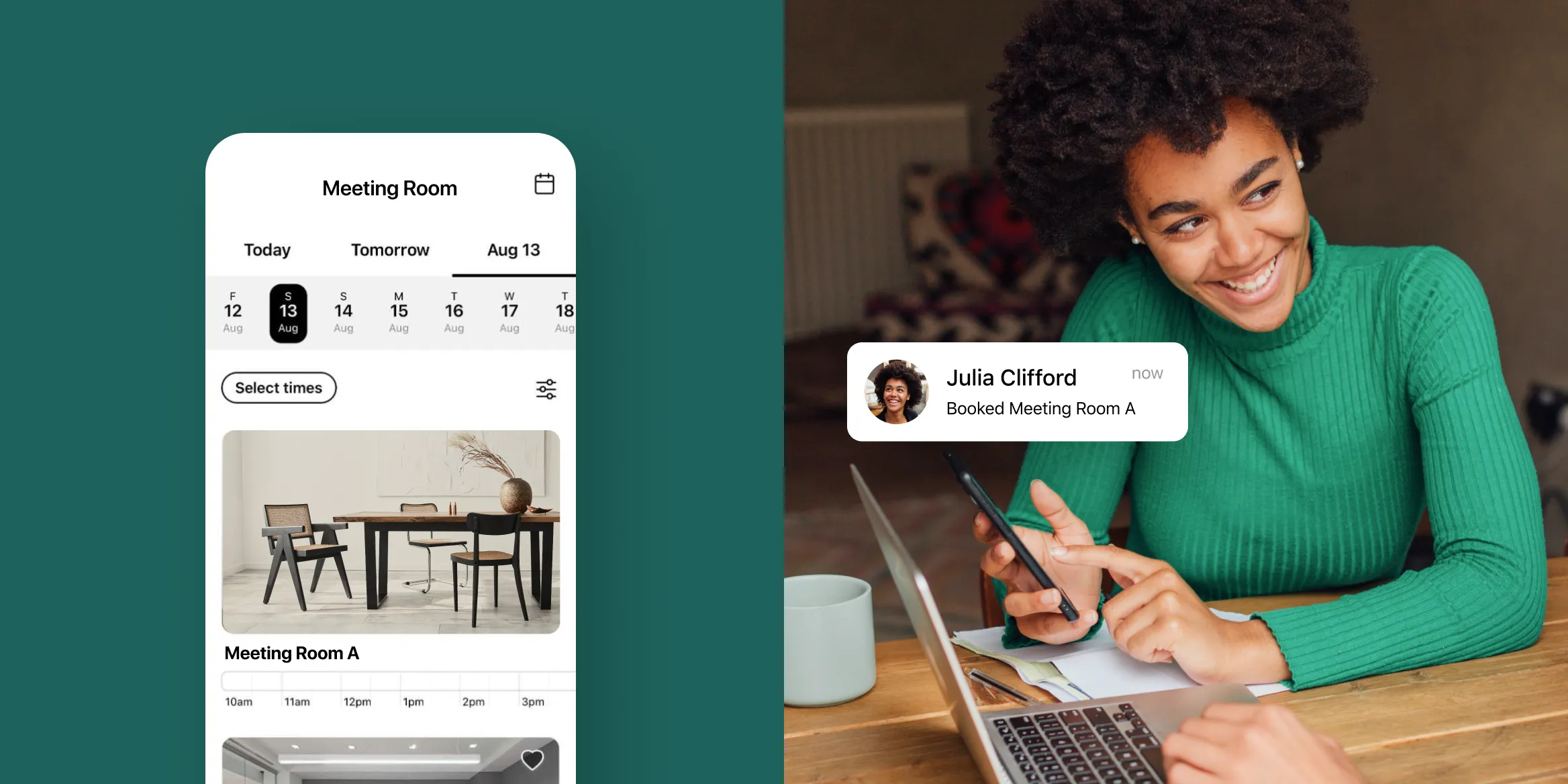Summary
- A coworking referral program is an initiative that rewards existing members for bringing new members into your space
- An effective referral program needs to provide value to your members and be profitable fir your business
- When creating a program, you’ll want to ensure you are being transparent, gathering feedback on the program, and keeping it fun for everyone involved
Have you ever thought about why you buy one product over another?
According to recent research, 84% of people place the most trust in referrals from people they know. In fact, research suggests that one conversation with a friend can drive five times more sales than a paid ad.
This makes referral, or word-of-mouth, marketing one of the most effective tools to grow your coworking community.
It’s also inexpensive, accessible, and you probably already have a base of happy members you can leverage to get things started.
In this post, we’ll take you through how to set up a referral program that can help take your coworking brand to new heights.
What is a coworking referral program?
A coworking referral program is an initiative that rewards existing members for bringing new members into your space.
They are set up so that your existing member receives something beneficial, like a discount on their membership fees, for every member they bring in who signs up for your space. This could mean:
- Giving a member a free month for referring a new member
- Giving a member $50 to put towards their monthly fees for every person they refer
- Offering commission on new sign-ups that they refer
If you have entrepreneurs working in your space with large networks, a referral program may be a great way of building your membership base at a relatively low cost.
The benefits of referral programs in coworking spaces
Referral programs are a popular choice for coworking spaces and other service-like industries because people trust people they know.
The work in operator’s favors because:
- The customer acquisition cost is lower than other channels
- The conversion rate of referrals is often higher than other channels
- It helps to grow a coworking community of like-minded people (if one member likes your space, chances are their friend may like it too)
- It’s relatively inexpensive, apart from the cost of offering the incentives
- It can scale infinitely
They also benefit your members by helping them save money on membership costs and can even be a way for them to build a network or reputation within the community.
How to create a referral program
Creating an incentivized word-of-mouth marketing program is relatively simple. It’s best to do a bit of math and work backwards from there.
1. Figure out your customer acquisition cost (CAC) and customer lifetime value (CLV)
Your customer acquisition cost (CAC) is the cost it takes for you to acquire a new customer. It can be calculated by dividing the total number of customers acquired by the cost of sales and marketing.
(Cost of sales) + (Cost of marketing) / Number of customers acquired
Your customer lifetime value is the average amount you can expect a customer to pay you while they are a member. This is calculated by taking the average monthly recurring revenue of your members and multiplying it by the number of months they are with you.
Customer Value x Average Customer Lifespan
Essentially, you’re trying to create an incentive that is less than or equal to your average CAC and less than your CLV. For example, if it typically costs you $150 to acquire a new customer, your incentive should equal $100 or less.
Pro tip: Take a look at your CLV to CAC ratio to determine if your marketing efforts are worth it. A CLV:CAC ratio of 3:1 is considered a good goal. This means, your customers should be paying you at least 3x what you pay to acquire them long-term.
2. Offer an incentive based on what your members value
Some incentive programs are based on giving out freebies, while others are centered around a discount for existing members. Most coworking spaces use the discount model because it is inexpensive and you know it’s something your members will value.
However, it’s worth doing a quick brainstorm and see if you can figure out anything else your members may want or feel incentivized to act on. It could be there is something they value more than a discount, that actually costs you less.
3. Advertise your referral program to new and existing members
Ensure that everyone knows about the referral program (and is reminded of it often!) to give it the highest chance of success. This could mean:
- Including a reminder about it in your weekly email newsletter
- Including it in your house rules
- Printing it and hanging it near your receptionist desk or in another high-traffic area
- Telling new members about it during their onboarding
- Including a “refer a friend” button in your coworking app
Tips for creating a referral program
Approaching members for referrals can feel awkward. Despite knowing that your members love your coworking space, you may be uncomfortable asking for referrals out of the blue.
This doesn’t have to be the case. By incentivizing participation, you can make the initial referral request that much easier. To help you get started, here are some best practices you can follow:
Make it a win/win
People are much more likely to refer their friends when they both get something from it. Offering a welcome bonus for the new member, in addition to a referral reward for the existing member who has made the referral ensures everyone comes away feeling like a winner.
Keep it fun
Gamifying the referral program can help fuel your members’ competitive streak. You could give away a grand prize to the member with the most converted referrals or create a points system with increasing discounts for reaching each referral milestone.
Promote, promote, and follow up
No one’s going to know about your referral program unless you tell them. Achieving awareness requires deliberate effort. Promote the referral program across your communication channels – your community feed, social media, website, newsletter, emails – and make sure to do it regularly (without overdoing it, of course).
Be transparent
Establish clear and simple guidelines for how referrers can earn rewards, including requirements and limits, and make this information easily accessible to members. This will help to avoid any misunderstandings that could damage your relationships.
Gather feedback
Ask your members what they think of your referral program. What aspects do they like and dislike? Are you offering the right incentives? Is there a way to improve their experience or make referring easier? Getting constructive feedback will help ensure your program remains an effective growth tool over the long term.
Say thanks
A good ‘thank you’ goes a long way. Make a point to let people know the status of their referrals and give them a pat on the back when they’re successful. Not only will it motivate them to refer again, but it will also help you build stronger relationships that support long term member retention.
How to track and measure the success of your referral program
The ability to track referrals effectively is a critical component of any referral program. If you can’t track referrals, members won’t be rewarded for participating and you won’t be able to figure out if it’s working.
Tracking your coworking referrals
There are a few different ways of tracking referrals. You can manually track referrals using a spreadsheet or you can even set up tags in your favorite CRM to keep track of who came from where.
You can also use a coworking software like Optix.
- Add a field to your registration form using the custom properties feature
- Collect referral sources from new or existing members
- Retrieve this information and filter your user lists by these properties when needed
When you identify that a referral meets your program criteria, you can record the successful conversion on the referring member’s profile and promptly reward them and encourage them to do it again.
Measuring the success of your referral program
Keeping track of referrals and measuring that against conversions will also help you determine how successful your program is overall.
When determining the success of your program, answer these questions:
- Are people referring new members to the space?
- Are these new members converting and buying a membership?
- How long are these new members staying?
- What are members saying about the referral program? Do they like it?
- What is the average cost of their membership on a monthly and lifetime basis?
- Is the cost to acquire members via referrals less than the cost of acquiring them via other channels?
- What does the CLV:CAC ratio look like for referrals?
Taking a look at the data points above will help you get a holistic understanding as to how your referral program is performing, both in the short and long term?
Getting started with referral marketing
When done right, a referral program can be a powerful marketing tool for your coworking space.
The key is to clearly outline the guidelines for participation and ensure everyone feels like they win by getting involved. Not only will this drive member growth, you’ll also end up with happier members ready to spread the word.
Looking for more marketing tips? Check out our 23 ideas for marketing your coworking space.







